Homeowner’s Guide to Improving a Bathroom with a Glass Corner Shower
18th Feb 2025
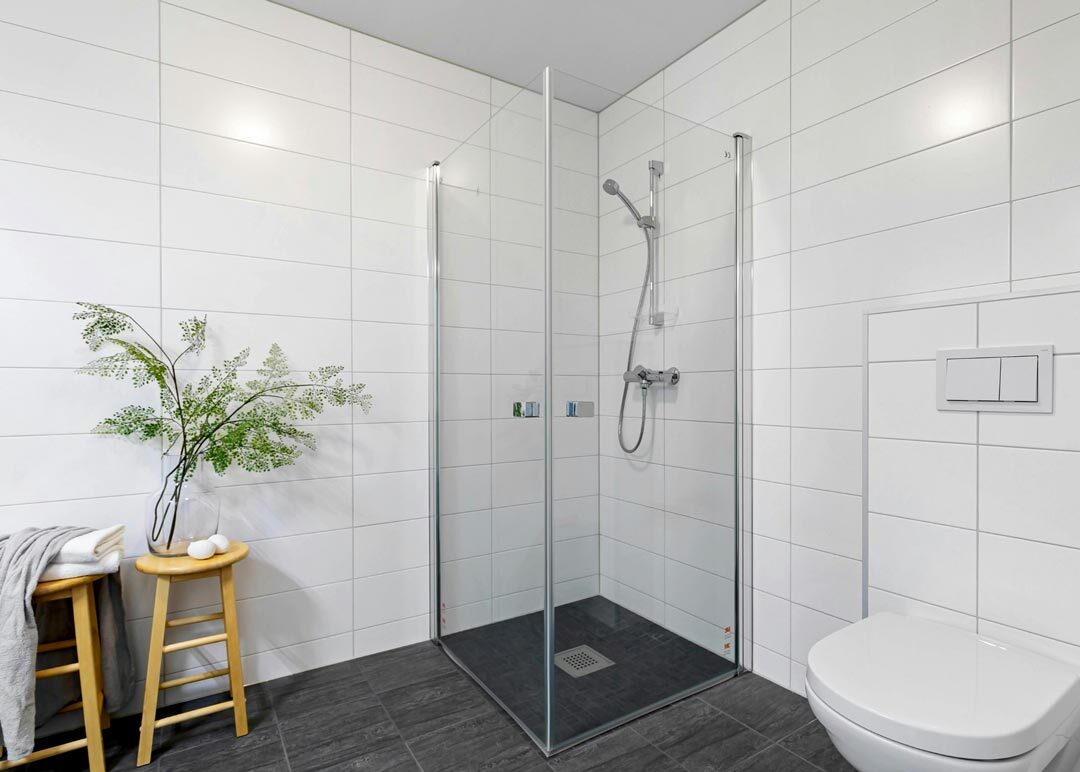
Your bathroom upgrade isn’t complete without a modern glass enclosure. In most bathrooms a corner shower is what makes sense in terms of space and convenience. We’ll walk you through different types of corner showers, the components needed to build them, and glass and metal options that will give your custom enclosure its unique character. It’s your choice of the layout, glass type, and hardware that unite to form your dream shower!
1. What is a corner shower?
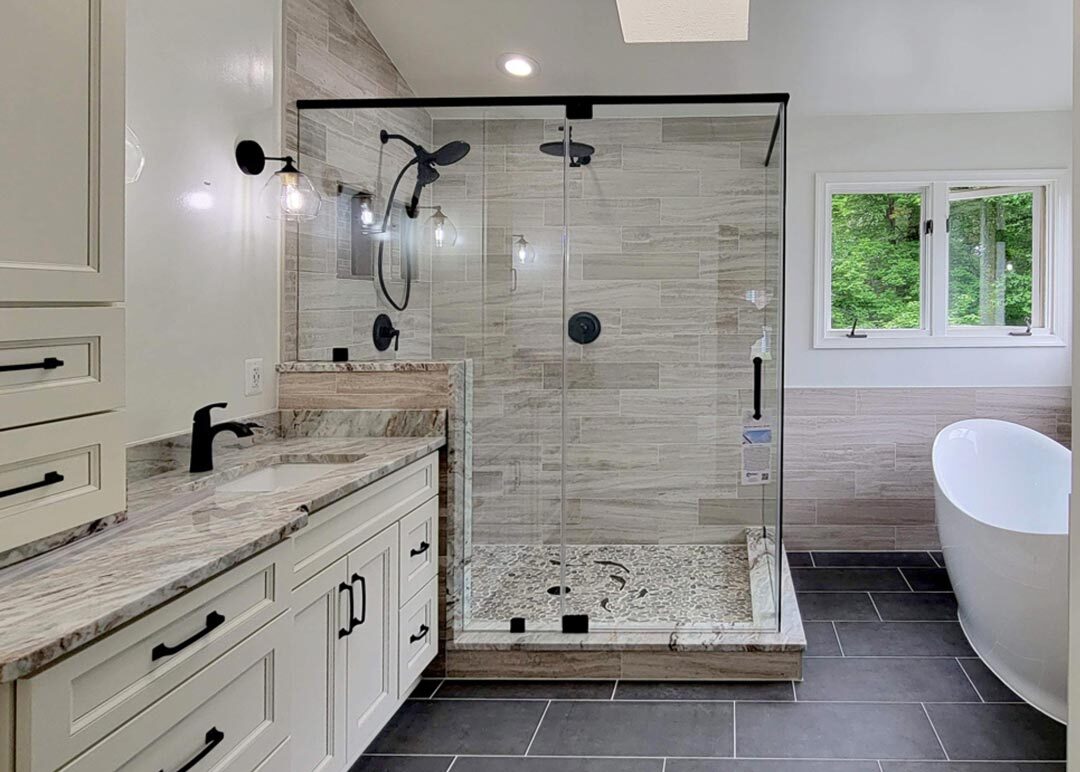
The term corner shower generally refers to a glass shower enclosure that makes use of and extends out from two existing bathroom walls. These walls are waterproofed and covered with tile or glass. Sheets of tempered glass are then installed to turn the corner into an enclosed showering area. Besides a shower head, other components found in corner showers can include:
- hand-held spray
- body jets
- overhead lights
- speakers
- grab bars
- glass shelves clamped to the wall
- sleeve over or through glass robe hook
- towel bar
Standard and custom corner shower designs are possible, so this type of enclosure is found in bathrooms large and small. Professional glass companies often install these units, but homeowners with the appropriate skill set will also DIY a glass corner shower project.
2. Does a glass corner shower have advantages over a shower curtain?
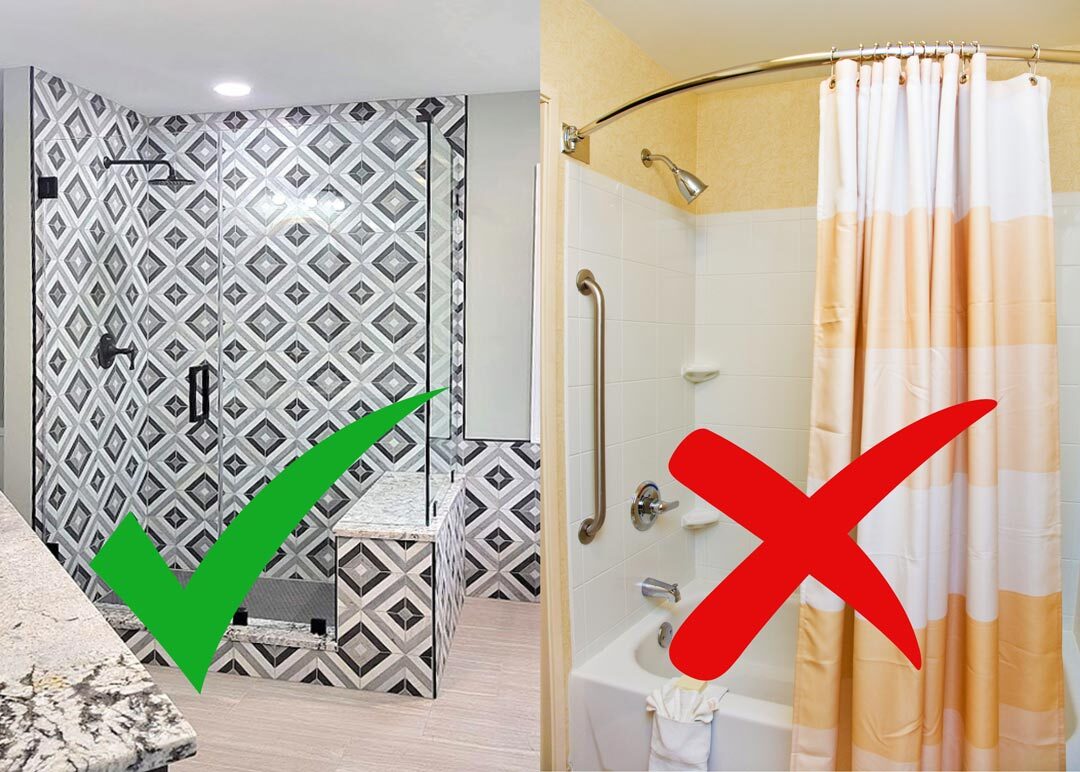
Shower curtain and rod combinations are cheaper, but glass corner showers offer features they can’t match. For one thing, a curtain and liner have to be carefully placed in order to actually keep water inside the stall. However, a glass shower will carry out this function as long as:
- The door is pulled shut.
- A spray is not aimed at a gap or seam.
Additionally, shower curtains tend to hide the shower stall and the tilework on the walls. With clear glass, you can make the room look bigger by keeping the shower’s interior visible. A transparent enclosure also allows beautiful shower tile to serve as one of the room’s focal points. It’s also important to remember how curtains and liners can fall prey to infestations of bacteria, mold, and mildew. However, glass does not absorb moisture, and it can be effectively dried, cleaned, and sanitized. Last but not least, a glass shower imparts elegance and a high-end style that a shower curtain cannot match.
3. How is a right angle corner shower different from a neo-angle corner shower?
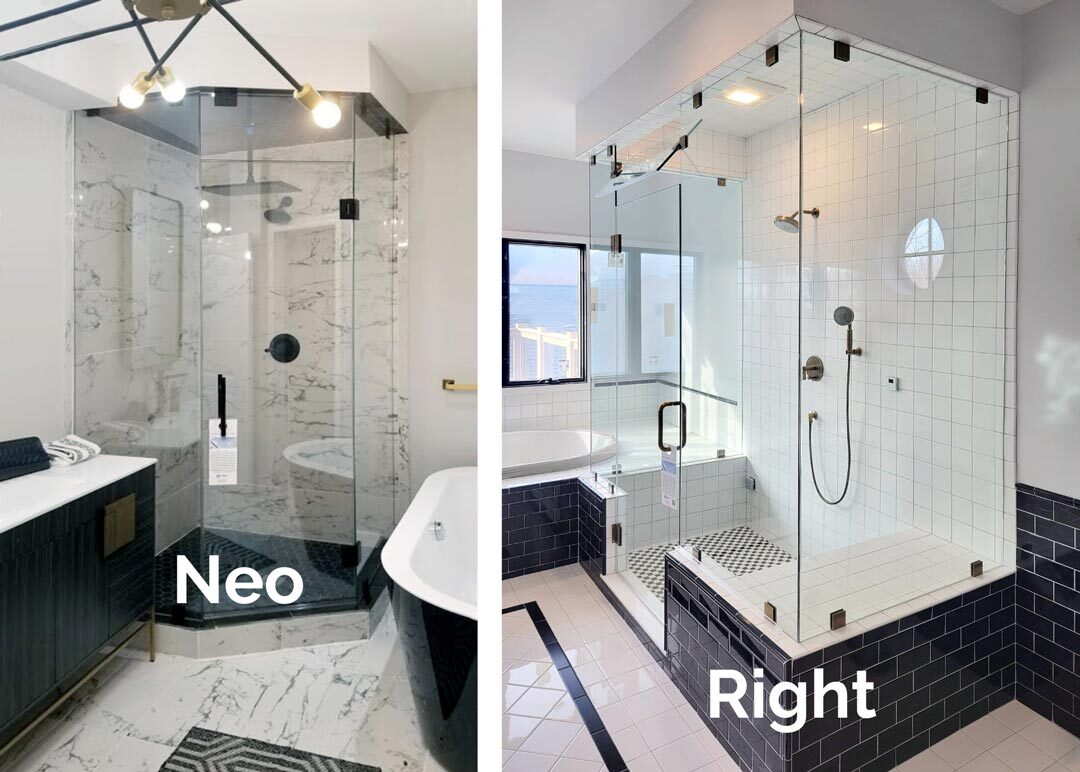
Two popular corner shower configurations are right angle (also called 90 degree enclosures) and neo-angle. As the name suggests, a right angle corner shower features pieces of glass that connect to each other and the bathroom walls at 90 degree angles. These are 4-sided enclosures, with one side typically including or consisting of a door panel.
On the other hand, a neo-angle corner shower is a 5-sided stall. Two glass sides connect to the tiled walls at right angles, but they stop short of meeting each other. Instead, they are connected by a third piece of glass (usually the hinged door), which meets them at 135 degree angles. Features of a neo-angle stall include:
- It does not extend quite as far out into the bathroom as a right angle stall, which can be good for space efficiency.
- Its 5-sided design is eye-catching.
- It will be equipped with a swinging door, not a sliding door.
- The choice of hardware and accessories can make it look more modern or more traditional.
4. Can a corner shower have a sliding door?
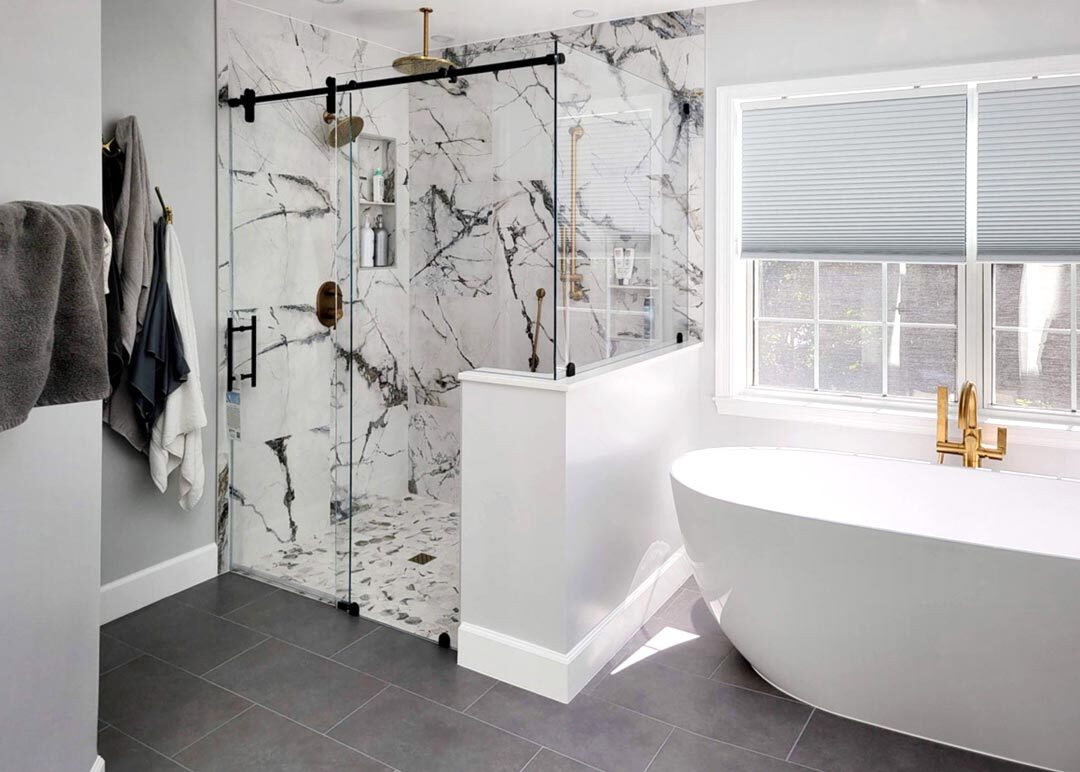
On the subject of sliding glass shower doors, you might be wondering if any corner shower designs allow for them, and the answer is yes. On a right angle corner enclosure, one side can consist of a frameless sliding shower door system. There are a couple variations from which you can choose. Some kits – like this one – have a rolling door panel alongside a stationary panel, while others feature double doors (see example here). Why might a sliding door be chosen instead of a swinging door?
- If there is not enough space for a hinged door to swing open freely, a sliding door is a more practical choice.
- The rollers and header on a frameless slider offer a modern look that is perfect for some bathroom designs.
- Dual sliding doors provide versatility.
Besides actual sliding door hardware, this type of enclosure will have other components such as clamps for the fixed glass return panel(s), a door pull, and appropriate vinyl seals.
5. Can a corner shower have an open entrance?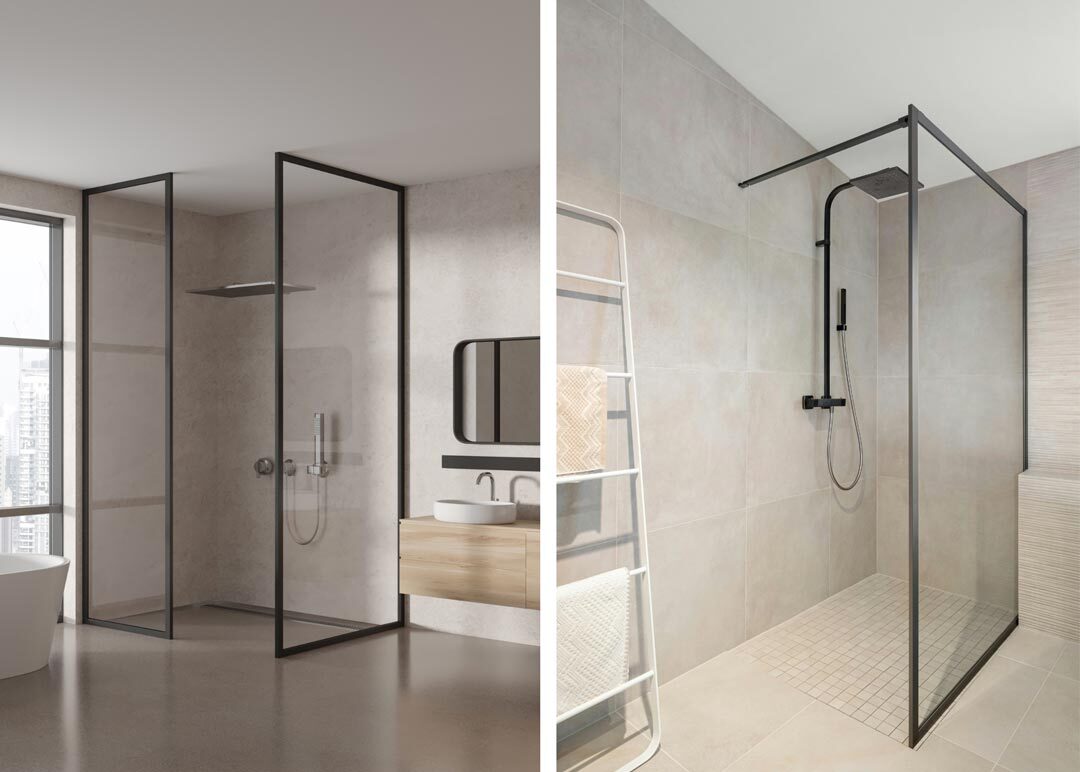
Yes! It’s possible to design a glass shower with an open entrance and no door panel. In fact, some homeowners also eliminate the curb to make a very accessible shower area. There are a few ways to achieve this type of enclosure:
- You can do a neo-angle stall but leave off one of the three glass sides or make one side just a partial wall that does not actually connect to the next piece of glass.
- A square or rectangular stall can be created and the doorway left open without a hinged or sliding panel.
- You can have a single splash panel installed in a bathroom corner to form a three-walled stall with one side unenclosed.
If you opt for a walk-in shower, additional steps are needed to keep water off the bathroom floor. For one thing, extra waterproofing should be done around the shower area. You also need to be mindful about where you place the shower head relative to the open entrance. Finally, the shower floor must slope appropriately toward a well-placed drain.
6. Why do some corner showers include a header?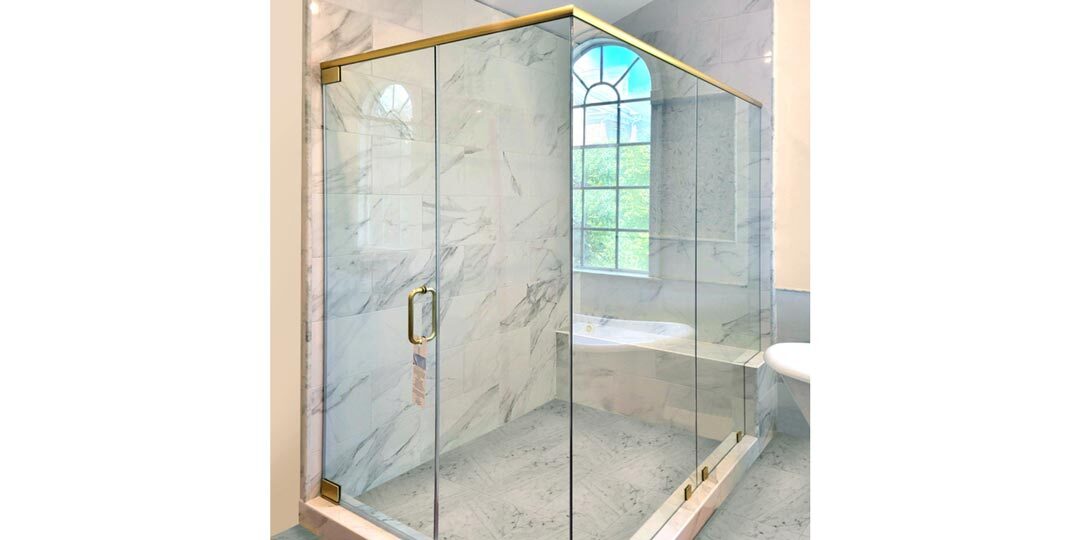
Some frameless glass shower enclosures – including corner stalls – have a header, which is a piece of metal extending across the top of the stall. There are several reasons for using this component:
- If you choose modern pivot hinges, they attach to surfaces above and below the enclosure. If the glass is not going all the way to the ceiling, a header can be installed to serve as the upper surface.
- Using a header allows for the safe use of slightly thinner glass which can reduce the cost of the project.
- The structure of some bathrooms requires this additional piece of metal for the stability and safety of the glass enclosure.
In summary, while many frameless shower configurations use as little metal as possible, a header can be a useful or even necessary component depending on your design, budget, and bathroom structure.
7. What hardware styles and finishes are available?
Whether your corner shower has many or few, the metal components go a long way toward giving it its personality and charm. Even small items like clamps and hinges have subtle details, primarily square or beveled edges. Pay close attention to these details when ordering so that all your pieces have the same profile.
For a hinged door, you can choose between side mount hinges and pivot hinges. Side mount hinges attach to the bathroom wall or an adjoining glass panel. These offer a traditional look, allow the door to seal when closed, and do not require a header for mounting. On the other hand, pivot hinges have a more modern style, do not allow the door to seal, may require a header, and offer a more minimalist look.
The door handle opens up even more design possibilities. You will likely choose an item in one of the following categories:
- Pull Handle: Available as singles or back to back sets, shower door pull handles are ergonomic and diverse. From ladder style handles to simple tubular pulls to more intricate designs, there’s a pull handle to complement just about every type of bathroom décor.
- Towel Bar: On a glass shower door, a towel bar can also be installed to serve as both a means of pulling the door open and shut and a place to hang your towel. These also come as single pieces and back to back pairs.
- Pull/Towel Bar Combo: Do you find features of both pulls and towel bars attractive? A pull/towel bar combo is a back to back set with the towel bar on the outside and a pull handle on the inside like these.
- Finger Pull: If you want to use as little metal as possible on your corner shower, a small finger pull is an unobtrusive door handle option.
- Knobs: Another minimalist product is a single knob or a back to back set. These are offered in both classic and modern shapes.
While the shapes and contours of your shower’s metal components are impactful, so is the hardware finish. In 2025, polished chrome and brushed nickel remain popular picks. These tones seem to stay relevant and acceptable even as trends come and go. For some year now, matte black hardware has been gaining traction, and this style seems here to stay for the foreseeable future. Since it is a neutral and classic tone, it pairs with just about any color and theme and is not likely to be a quickly disappearing fad. We’ve also seen a re-emergence of gold based tones with a movement away from the high-gloss finishes of the 90s. Instead, satin brass and brushed bronze are popular options for adding a touch of delicate luxury to a bathroom.
8. How should I choose a glass style for a corner shower?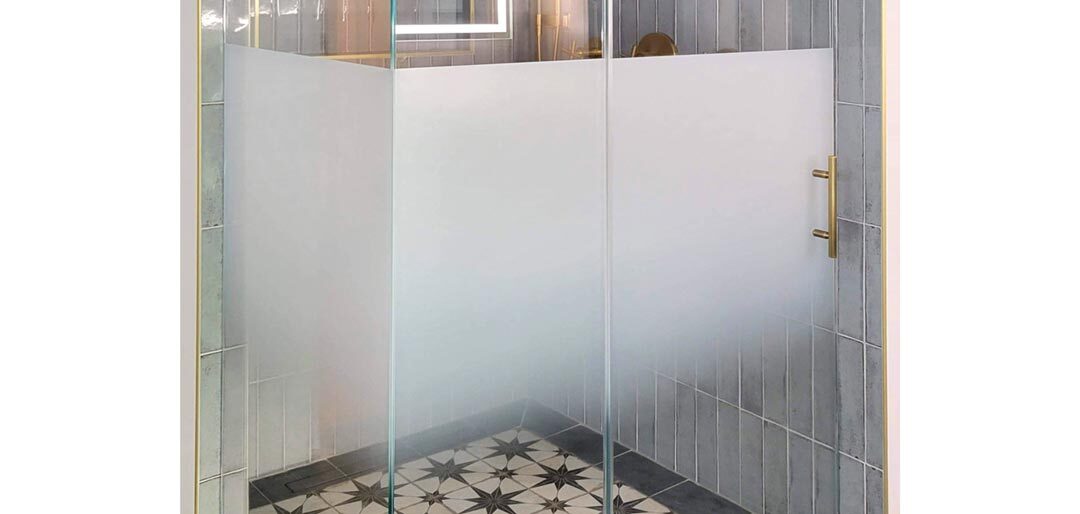
Along with the style and finish of the hardware, the type of glass used will determine your corner shower’s overall look and feel. Most enclosures are constructed from clear or ultra-clear glass. Standard clear glass is transparent, but there is greenish coloration around the edges of each glass panel. The iron content is reduced in ultra-clear glass to minimize this effect. Both clear and ultra-clear shower glass offer the following features:
- Highlights your shower’s interior rather than hiding it behind a curtain or obscure glass.
- Has a smooth, flat surface that makes for easier care and cleaning.
- Allows lots of light into the shower stall.
- Makes both the shower area and the rest of the bathroom feel more spacious by creating a continuous line of sight between them.
- Matches any color scheme and most bathroom styles and themes.
In some cases, however, a private area for showering is better. Acid-etched, sand-blasted, patterned, and tinted glass panels add various levels of privacy to the area they surround. Also, many designs are offered in the patterned glass category, so you’re likely to find the perfect pattern for your décor goals. Another approach that’s becoming more popular is glass that has a frosted section around the middle, with clear glass above and below. This can be achieved through custom etching or sandblasting, and it gives a degree of privacy while still holding onto the benefits of clear shower glass.
9. What is the best way to clean and care for a glass corner shower?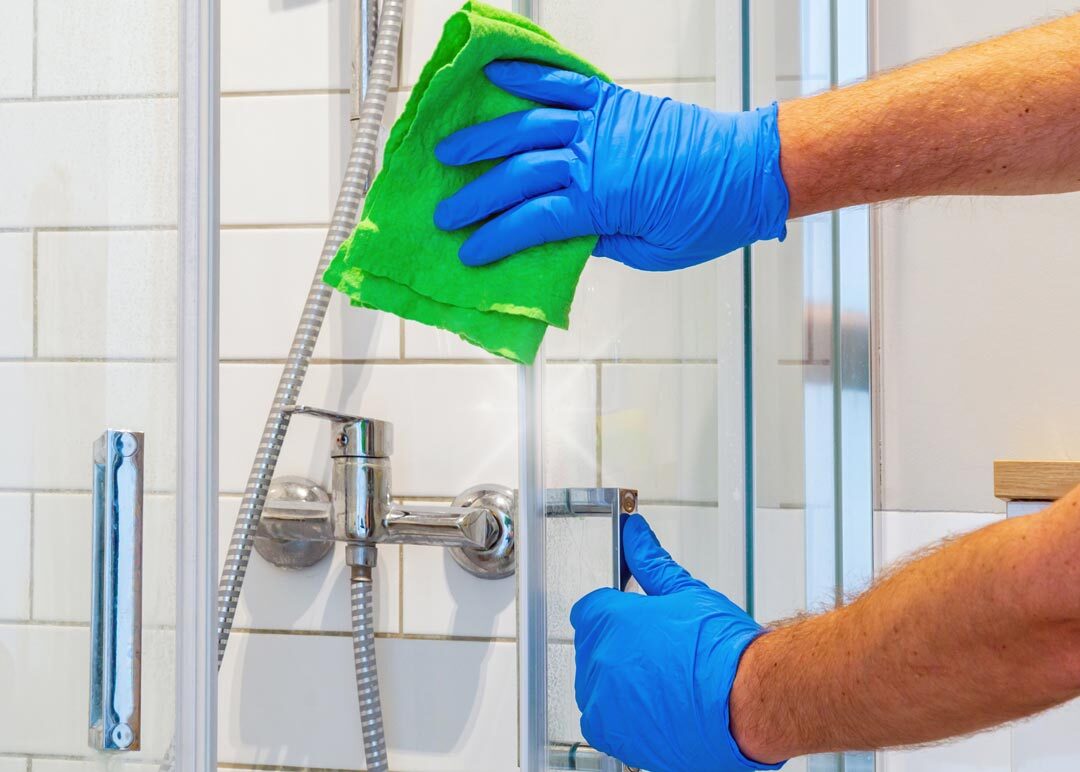
Once you’ve chosen your configuration, hardware, and glass and the corner shower is in place, you’ll want to keep it looking fresh and sparkling. We’ll go over some commonsense preventative measures you can take as well as tips for successful cleaning.
- Order protected glass or apply a protective coating. A glass shower enclosure can be built from glass with a permanently sealed surface, but if you already have normal glass, don’t despair. Coat the glass with a spray-on glass protectat and re-apply as directed.
- Remove water from the glass and metal when you finish showering. If you keep a squeegee in the stall and some towels nearby, this will be the work of just a couple minutes. Prompt drying minimizes the risk of corrosion and soap scum buildup.
- Clean the glass and metal components on a regular schedule. You can start with weekly washings and adjust this timetable as needed.
- Use approved cleaners on the glass or make your own by mixing water and vinegar in a 1-1 ration. Wash the hardware with a gentle compound of water and liquid soap, making sure to promptly rinse and dry it.
- Do NOT use anything harsh, abrasive, or scratchy on either the glass or the hardware to avoid damaging their surfaces.
In summary, preventative care, regular cleaning, and use of appropriate products will help keep your corner shower looking its best.
Shop Glass Simple for corner shower hardware needs.
Whether you are a homeowner planning a DIY corner shower install or a glass professional, we invite to check out Glass Simple’s selection of products in our own brand as well as FHC and Portals. The Glass Simple team is committed to excellent customer care and timely processing whether the order is large or small. B2B accounts receive significant price reductions, so call today to learn more – (571)707-7760!




